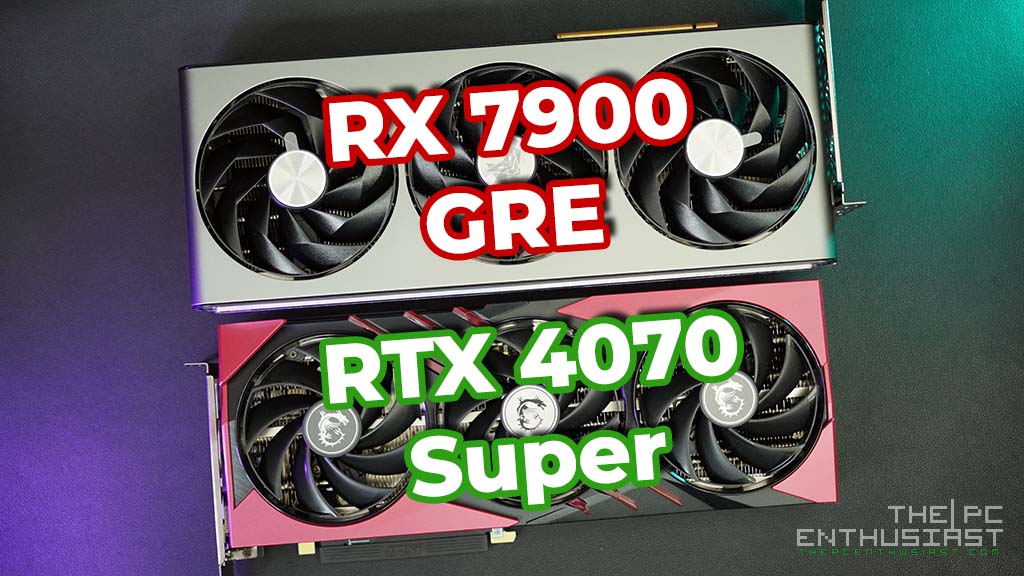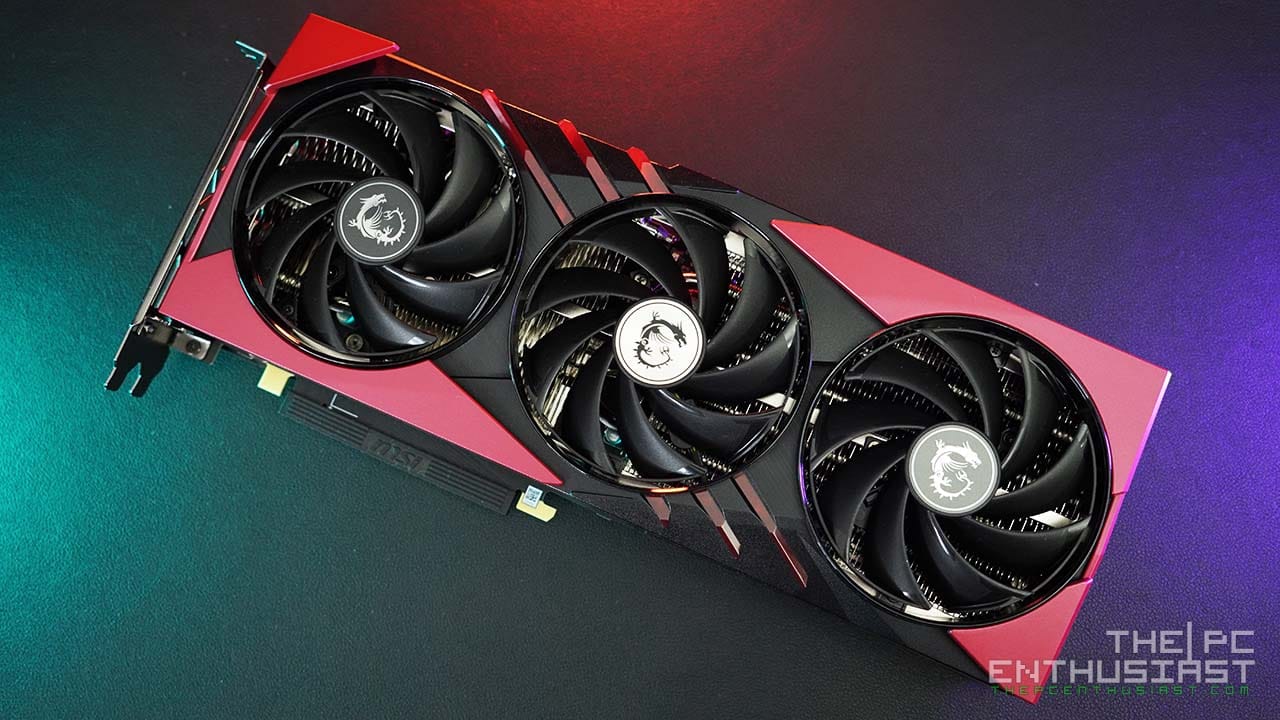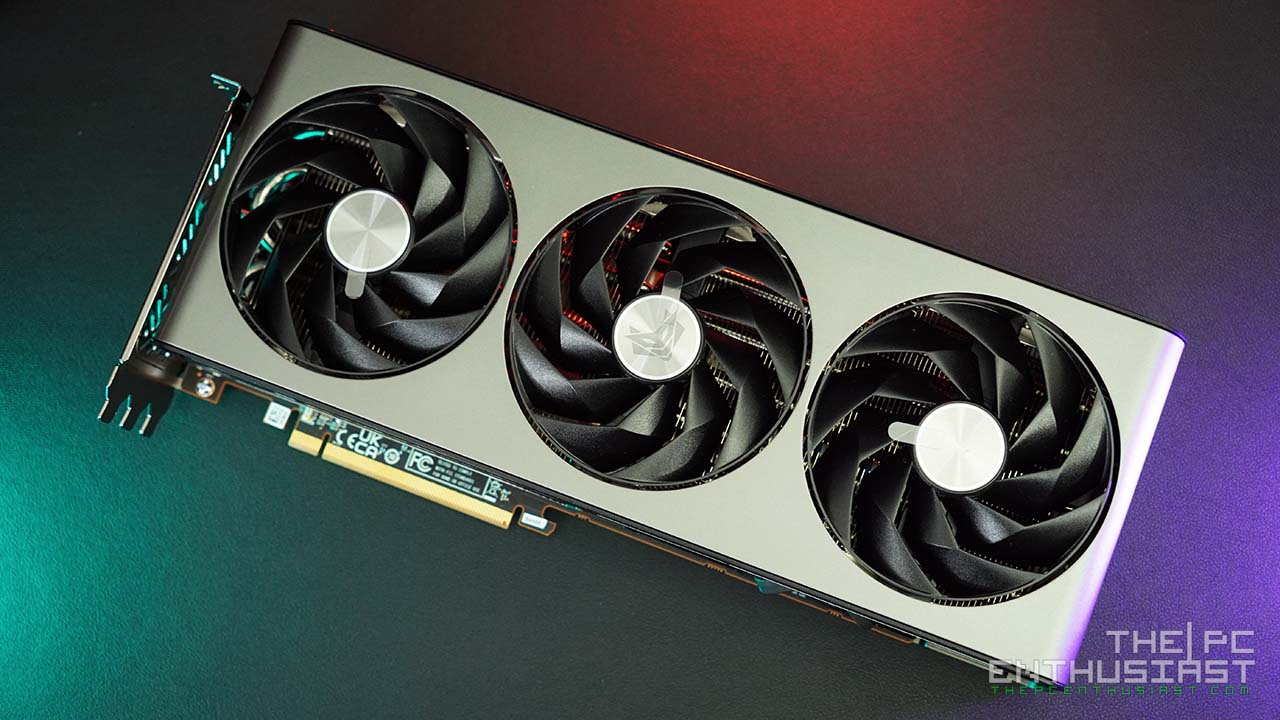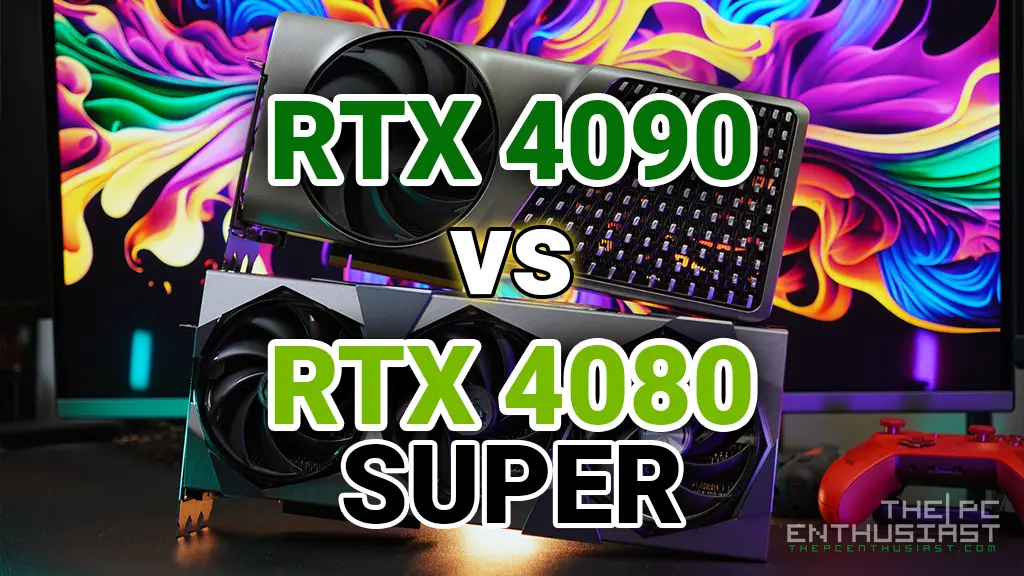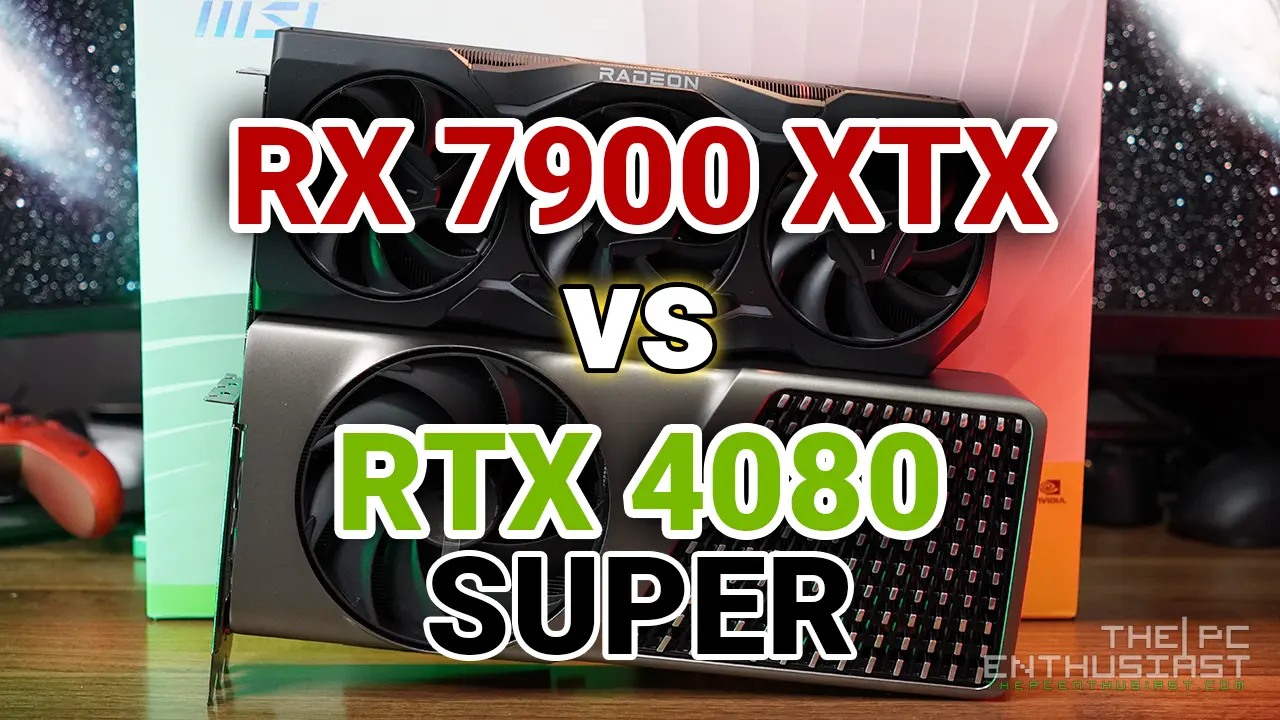One of AMD‘s latest GPUs is the Radeon RX 7800 XT – a mainstream GPU designed for 1440p gamers and is a direct competitor of NVIDIA’s GeForce RTX 4070. Unlike our other AMD vs. NVIDIA flagship GPU comparison, the RX 7800 XT competes with the RTX 4070 in performance and pricing. After AMD released the RX 7800 XT, some of the RTX 4070 cards dropped in price, making it a difficult decision for gamers. In this article, let’s find out how fast the RX 7800 XT is vs. the RTX 4070, whether the RX 7800 XT is worth getting over the RTX 4070, and the pros and cons of each GPU. Please continue reading our review comparison below.

Comparing RX 7800 XT vs RTX 4070 – The Results Are Surprising
A quick overview of both GPUs: the AMD Radeon RX 7800 XT is a mid-range GPU designed for 1440p gaming. Well, the RX 7700 XT is also a mid-range GPU, but that one is just in a weird spot, and the 7800 XT overshadows the 7700 XT. The RX 7800 XT is based on AMD’s RDNA 3 architecture, and similar to the 7900 series, it also uses a chiplet design. AMD used a 5nm TSMC process for its Graphics Compute Die (GDC) and a 6nm process for the Memory Cache Die (MCD). The RX 7800 XT uses a Navi 32 GPU, with 3840 stream processors and 16GB of GDDR6 VRAM running on a 256-bit memory interface.
Meanwhile, the GeForce RTX 4070 features NVIDIA’s Ada Lovelace architecture with AD104 GPU. It has 5,888 CUDA cores with a boost clock speed of 2475MHz. It also has 184 4th gen Tensor cores, 46 3rd gen Ada RT cores, and 12GB of GDDR6X memory running on a 192-bit interface. NVIDIA is clearly ahead when it comes to ray tracing technology and upscaling solutions. Nevertheless, AMD is catching up, but we won’t know for sure if AMD can match NVIDIA’s ray tracing and upscaling technology by the time the next generation of GPUs is released.
Other Features
Generally, AMD has the advantage regarding the amount of VRAM they use on their graphics cards. However, NVIDIA uses a faster and more efficient GDDR6X memory on their RTX 40 series GPUs. But, having a faster or larger VRAM doesn’t necessarily result in one graphics card performing better than the other. Of course, if the game or application you run heavily relies on the graphics card’s VRAM, the higher the VRAM is usually better.
While both the RX 7800 XT and RTX 4070 support AV1 encoding, aside from ray tracing and upscaling, NVIDIA has a trick under its sleeve called DLSS 2 AI Frame Generation. And just recently, NVIDIA released DLSS 3.5 or Ray Reconstruction. On the software side of things, NVIDIA is ahead.
Below are the specifications of the RTX 4070 and RX 7800 XT GPUs. After that, let’s get straight to the benchmark results.
GeForce RTX 4070 vs Radeon RX 7800 XT Specifications
| Graphics Card | GeForce RTX 4070 | AMD Radeon RX 7800 XT |
|---|---|---|
| Fabrication Process | TSMC 4N NVIDIA Custom Process | GCD: TSMC 5nm MCD: TSMC 6nm |
| Transistor Count | 35.8 billion | 28.1 billion |
| Architecture | Ada Lovelace | RDNA3 |
| GPU | AD104 | Navi 32 |
| CUDA Cores / Stream Processors | 5888 | 3840 |
| Tensor Cores | 184 (4th Gen) | N/A |
| RT Cores / Ray Accelerators | 46 (3rd Gen) | 60 |
| Texture Units | 184 | 240 |
| ROPs | 64 | 96 |
| Boost Clock | 2475 MHz | 2430 MHz |
| Memory Clock | 10500 MHz | 2438 MHz |
| Effective Memory | 21 Gbps | 19.5 Gbps |
| L2 / Infinity Cache | 36.8 MB | 64MB |
| VRAM Size/Type | 12GB GDDR6X | 16GB GDDR6 |
| Memory Interface | 192-bit | 256-bit |
| Total Memory Bandwidth | 504 GB/s | 624 GB/s |
| Texture Rate | 455.4 Gigatexels/sec | 583.2 Gigatexels/sec |
| Connectors | 3x DisplayPort, 1x HDMI | 2x DisplayPort, USB-C, HDMI |
| Minimum Power Supply | 650 Watts | 700 W |
| TGP / TDP | 200 Watts | 263 Watts |
| PCI Express Interface | Gen 4 | Gen 4 |
| Release Date | April 2023 | September 2023 |
| Launch Price | $599 | $499 |
Check the latest pricing and availability: (#ad)
GeForce RTX 4070 graphic cards are available on Amazon.com here.
Radeon RX 7800 XT graphics cards are available on Amazon.com here.
Test System Used
| Operating System | Windows 11 Pro |
| Processor | AMD Ryzen 7 7700X |
| Motherboard | MSI MPG X670E Carbon WiFi |
| Memory | Corsair Vengeance RGB DDR5-6000MHz CL30 AMD EXPO |
| Graphics Card | XFX Speedster Qick 319 Radeon RX 7800 XT MSI GeForce RTX 4070 Ventus 3X |
| OS Drive | MSI Spatium M480 Play |
| Game Drive | SanDisk Extreme PRO Portable SSD V2 and Extreme Portable SSD V2 |
| Power Supply | MSI MPG A1000G PCIE5 |
| Chassis | MSI MPG Velox 100P Airflow |
| Monitor | MSI Optix MPG321UR-QD 4K 144Hz |
RTX 4080 vs RX 7900 XTX – Synthetic Benchmarks

In the synthetic benchmarks, the Radeon RX 7800 XT is generally faster than the RTX 4070. We can see a noticeable performance difference in the Fire Strike benchmark suite. However, the RTX 4070 slightly outperformed the RX 7800 XT in Port Royal and Speed Way benchmarks.
The reason why the RX 7800 XT got surpassed in the latter two tests is because both are ray tracing benchmarks. Port Royal is primarily a ray tracing benchmark, and Speed Way is the newer test that also uses ray tracing. Speed Way is “an ideal benchmark for comparing the DirectX 12 Ultimate performance of the latest graphics cards”.
These are just synthetic benchmarks and are graphics scores. So, let’s find out next how these two GPUs compare in actual games.
RTX 4070 vs RX 7800 XT – RT and DLSS/FSR Game Benchmarks
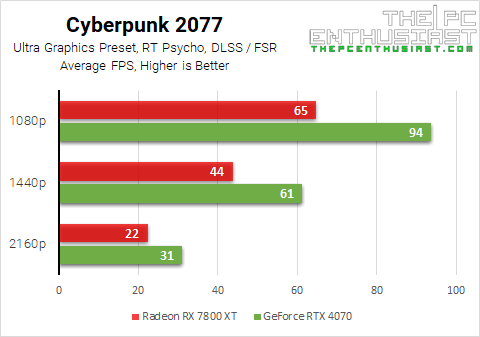
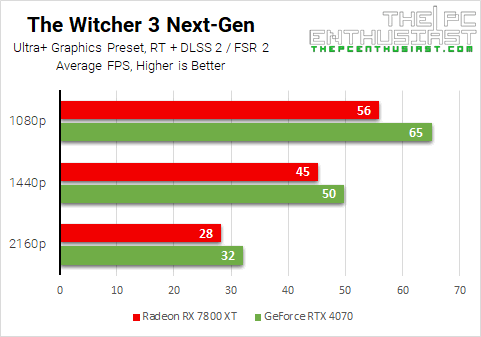
I only tested a couple of games with ray tracing enabled since I knew NVIDIA would end up on top. As you can see from the results above, games with ray tracing will benefit more from using an RTX 4070. You can still get decent frame rates with an RX 7800 XT when ray tracing is enabled, but you will need to adjust and lower the graphics quality to get higher frame rates.
When it comes to upscaling technology, NVIDIA GPUs can use both FSR 2.0 and DLSS. Meanwhile, AMD GPUs can only use FSR. Regarding quality, though, NVIDIA’s DLSS is overall superior to AMD’s upscaling technology. Again, I wouldn’t be surprised since NVIDIA was the first to implement and use ray tracing and DLSS on their GPUs. And recently, NVIDIA announced its DLSS 3.5 or Ray Reconstruction, which also works with older RTX GPUs.
Now, let’s check out how their performance differs when it comes to traditional rasterization.
RTX 4070 vs RX 7800 XT – Rasterization Game Benchmarks


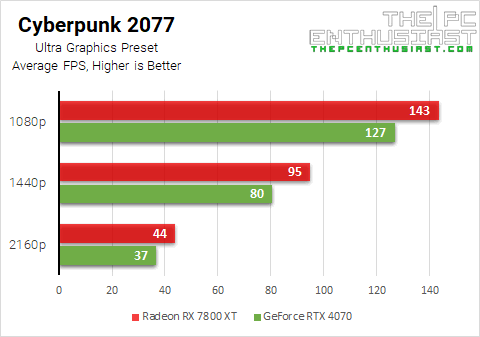

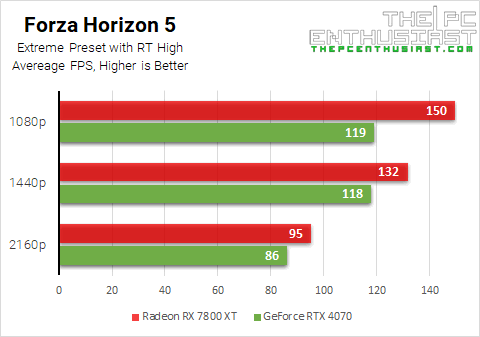

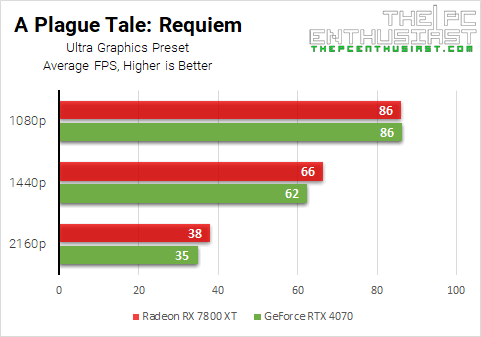
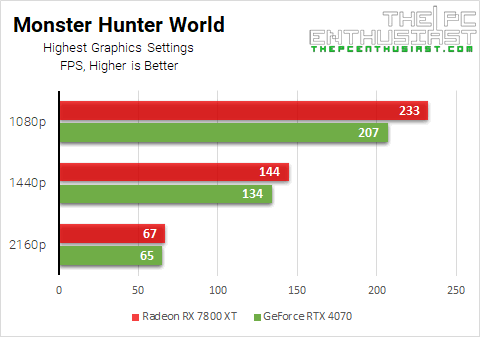
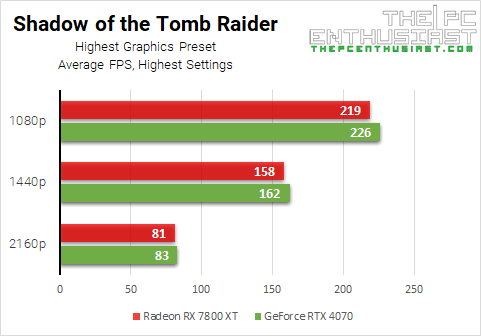
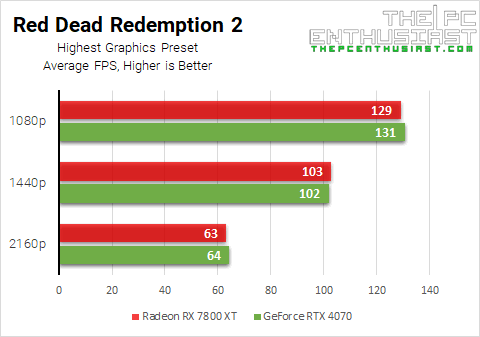

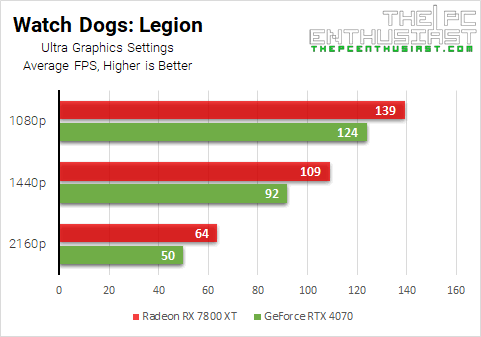
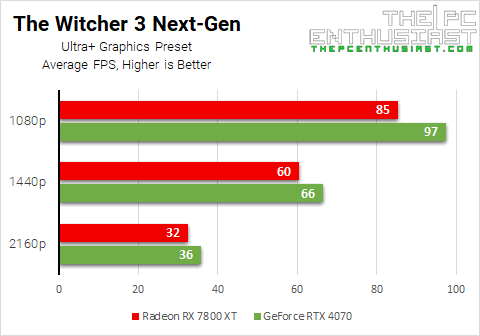
With pure rasterization only, the Radeon RX 7800 XT is faster than the RTX 4070 in most games above. If a game is AMD-sponsored or favors AMD GPUs, expect the RX 7800 XT to perform better, sometimes substantially. For example, in Call of Duty Modern Warfare II, the RX 7800 XT performed faster than the RTX 4070.
But I am surprised that the RX 7800 XT did well on Cyberpunk 2077 and on Forza Horizon 5, even when ray tracing was enabled for the cars. I expected it would do well on Red Dead Redemption 2, but it was only on par with the RTX 4070 in this game.
Let’s combine these results and see the general picture.
Summary Results
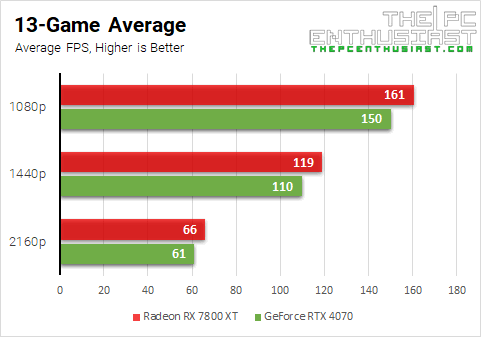
The 13-game average above only covers the traditional rasterization, including Forza Horizon 5 with RT enabled. I did not include Cyberpunk 2077 and The Witcher 3’s ray tracing results since it would skew the results toward the RTX 4070’s favor.
When it comes to raw performance, the Radeon RX 7800 XT wins, but only by a small margin. When I was testing and reviewing the RX 7800 XT, I expected that the RX 7800 XT would be around 10% faster or more than the RTX 4070. However, that wasn’t the case.
The RX 7800 XT is only around 7% faster in 1080p and only around 8% faster in 1440p and 4K, on average. However, the RTX 4070 would outperform the RX 7800 XT if the games involved ray tracing in general. If you plan to play games, or at least most of your games have ray tracing enabled, you would benefit more from the RTX 4070.
Considering that the RX 7800 XT starts at $499, while the RTX 4070 starts at $599, the latter is 20% more expensive. This means the RTX 4070 is basically the more expensive card, but the RX 7800 XT is slightly faster. If that’s the case, the choice between two GPUs is clear and a no-brainer, right?
Well, that’s what I thought at first. But after checking out the recent pricing and availability, I am having second thoughts on who is the clear winner here.
Price Difference and Availability
As mentioned, the Radeon RX 7800 XT starts at $499. However, most RX 7800 XT cards are from AMD’s AIC partners, and these cards are usually custom-designed with better cooling, RGB lighting, and all the flare. As a result, most RX 7800 XT cards I see on the market sell for around $520 to $620. On top of that, the availability or supply of the RX 7800 XT is somewhat on the low side. It could be because the RX 7800 XT sold fast after people saw the positive reviews.
On the other hand, most RTX 4070 cards are sticking to the MSRP set by NVIDIA, which is $599. At the same time, some premium RTX 4070 cards sell above $600. However, after the release of the RX 7800 XT, some of the RTX 4070 cards’ prices dropped to $549, making it somewhat on par with the other RX 7800 XT when it comes to pricing.
Currently, the MSI RTX 4070 Ventus 2X OC, MSI RTX 4070 Ventus 2X White 12G OC, Zotac RTX 4070 Twin Edge OC (Spider-Man Edition), and Gigabyte RTX 4070 WindForce OC are selling for just around $549. It looks like NVIDIA doesn’t want AMD to win in the mid-range segment too.
Check the latest pricing and availability: (#ad)
GeForce RTX 4070 graphic cards are available on Amazon.com here.
Radeon RX 7800 XT graphics cards are available on Amazon.com here.

Radeon RX 7800 XT vs GeForce RTX 4070 Conclusion – Is there a winner?
Similar to our RX 7900 XTX vs RTX 4080 comparison, the answer or the winner may not be as clear as day. I’m certain AMD fans would choose the RX 7800 XT, and NVIDIA fans would prefer the RTX 4070. But how about those in between who have no brand loyalty and just want the best GPU for their setup or the GPU that is worth your money?
Let’s break down the reasons why you should choose the RX 7800 XT over the RTX 4070 and vice versa.
Reasons to Choose Radeon RX 7800 XT:
- It is generally cheaper than the RTX 4070;
- If your gaming monitor is 1440p or 1080p, but preferably the former;
- It has better rasterization performance while costing cheaper or similar, depending on the graphics card model;
- If ray tracing and/or upscaling technology is not a big issue for you,
- Or if you use software or applications that would benefit from an AMD GPU.
Reasons to Choose GeForce RTX 4070:
- It is an excellent GPU for 1440p gaming;
- Better ray tracing performance and upscaling technology;
- It is more efficient and consumes less power than the RX 7800 XT;
- Get access to DLSS 3 Frame Generation, making gameplay smoother, and newly released DLSS 3.5 Ray Reconstruction;
- It has a better video encoder (NVENC) with AV1 support;
- If the software/applications you use can take advantage of NVIDIA’s GPU acceleration or CUDA technology,
- If you spot an RTX 4070 with a $550 price tag, or better yet, lower.
Generally speaking, the main strength of AMD’s Radeon RX 7800 XT is its raw performance and competitive pricing. That is until NVIDIA dropped the price floor, and we now see a few RTX 4070 cards selling for around $550. Not to mention, some of the better-looking RX 7800 XT are priced relatively high, losing their advantage when it comes to pricing.
At the end of the day, I think it’s not a clear win for AMD. However, the RX 7800 XT does have the advantage when it comes to price/performance. But there are other factors that you should consider. There’s no single answer to this since we all have different needs. That’s the beauty of the DIY market: we have the option to choose which hardware to get depending on our situation or application.
If you want to see how the Radeon RX 7800 XT stacks up against other GPUs, you can check out our RX 7800 XT review here. Or, if you are set on getting the RTX 4070, you may want to check out some of the best RTX 4070 cards here.

